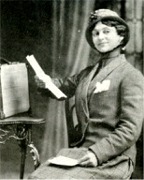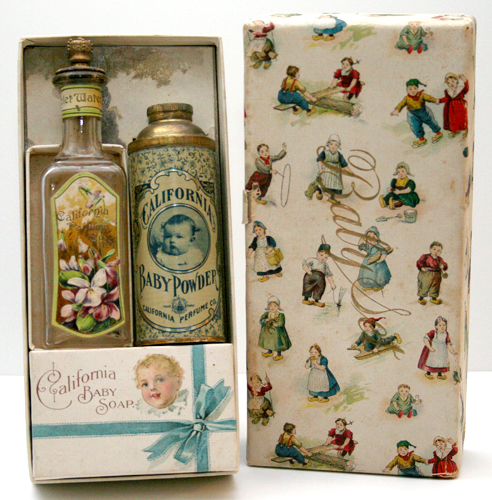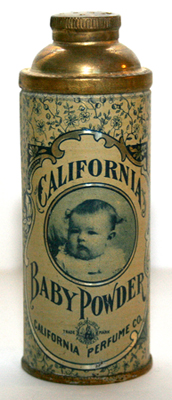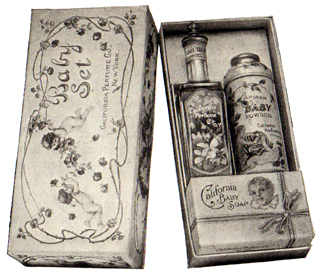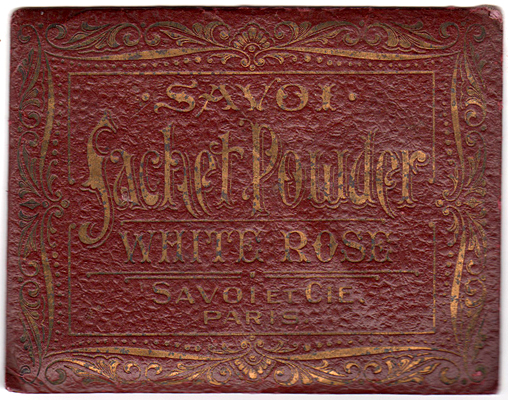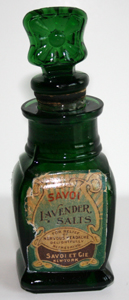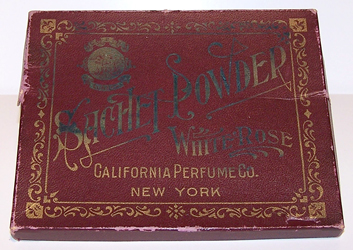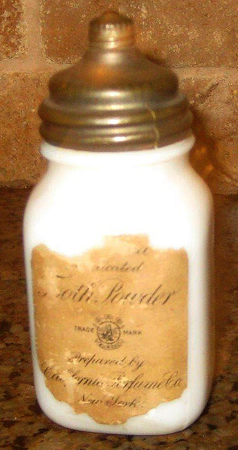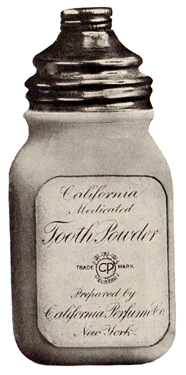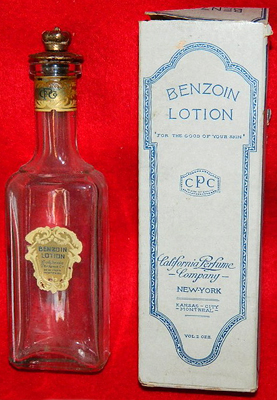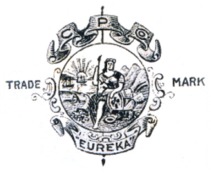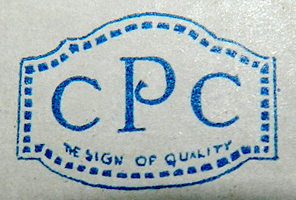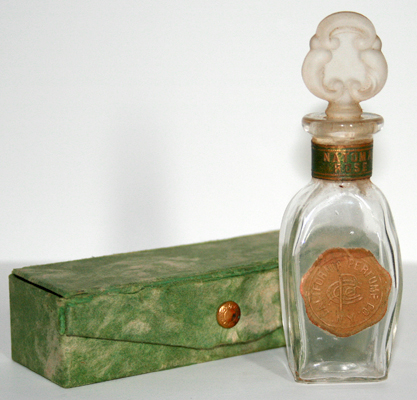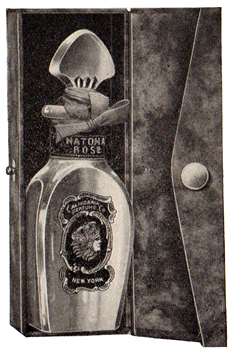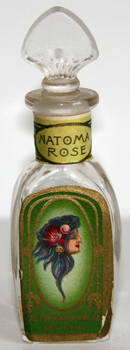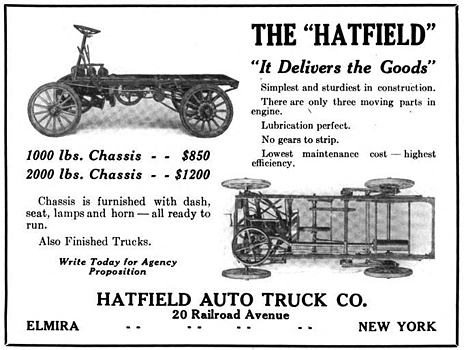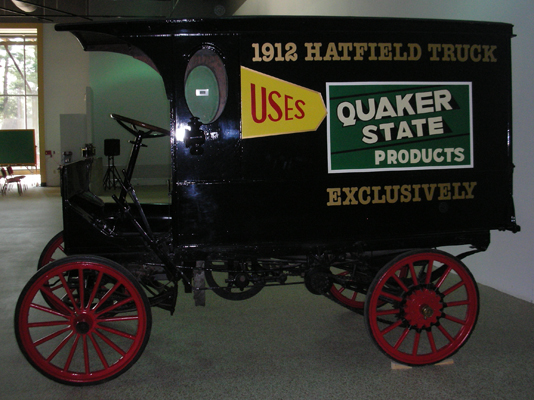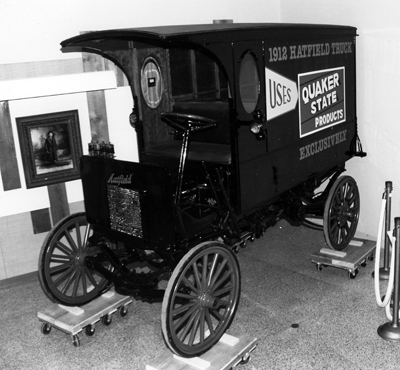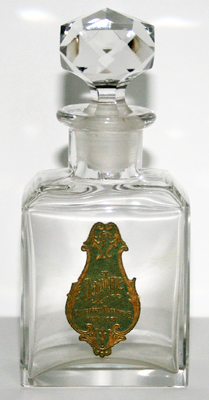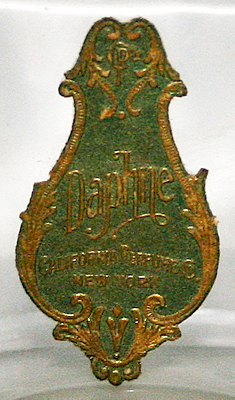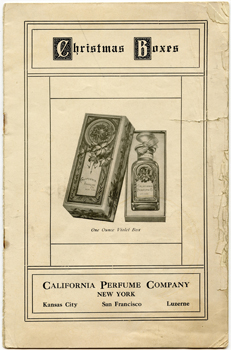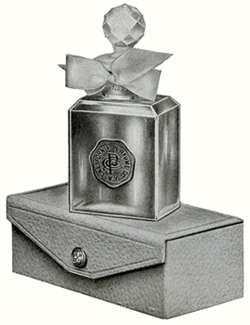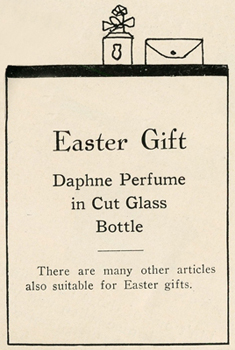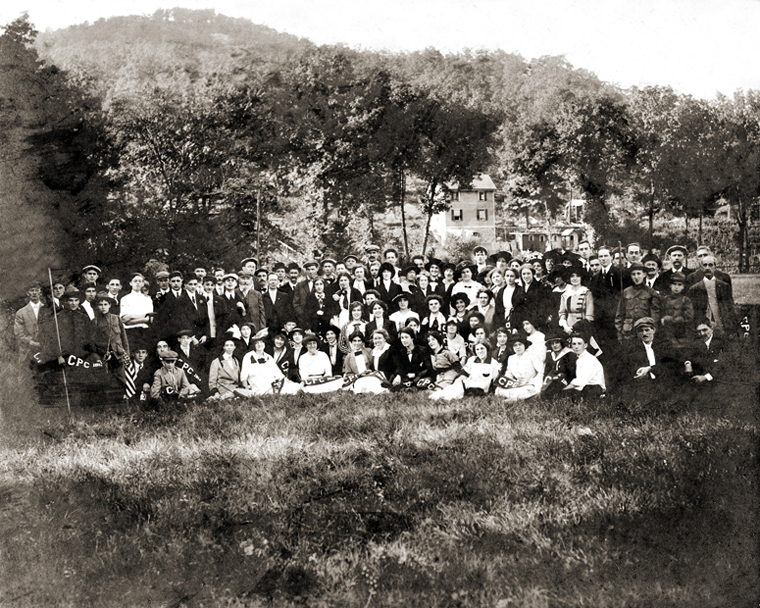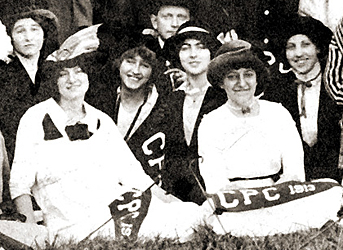The Newest Finds
Main Navigation | Previous 'Newest' Finds
Extraordinary Find: The First CPC Baby
Set!
~ 1909-1910
|
I know I sound like a broken record, however I have to say it once again, "California Perfume Company treasures, some of the rarest pieces, are still being found today!! And this 1910-1912 Baby Set IS...and I strongly emphasis the word "IS"...among the rarest of CPC items to have ever been found! A huge Thank You goes to George Gaspar for the opportunity and privilege to photograph this rarity for all collectors to enjoy.
I need to set a foundation here before we delve into some heavy detective work in this article. The California Perfume Company was NOT GOOD at keeping their earlier catalogs up to date with the newest pictures or illustrations of their products as containers (bottles, tins, and boxes) or labels changed. Thus is essential to remember as we research our treasure Baby Set above. McConnell introduced baby products to the CPC inventory by 1895: California Baby Soap and California Baby Powder, confirmed by a 1895 Order Sheet. The California Baby Powder tin was first illustrated on page 33 of the 1898 For Beauty's Toilet Catalog while the California Baby Soap was first depicted on page 30 of the 1902 For Beauty, Health, and Home Catalog. McConnell used the same baby powder tin illustration in his catalogs up through 1906. The 1907 color CP Book catalog contained no picture of the baby powder tin; though interestingly, some of the 1907 depictions of the California Perfume Company products show container updates from earlier catalogs. The tin pictured to the immediate left was the second version of the CPC's California Baby Powder sold between approximately 1907 and 1909. This particular tin was illustrated in the 1908 CP Book and 1909 CP Book. Then, in 1910, a third version of the California Baby Powder tin was introduced. This spectacular find represents only the second "known" Savoi et Cie, Paris product discovered thus far. The unopened sachet envelope measures 3 7/8 inches x 5 inches. The color of the envelope is a deep burgundy accented with gold lettering. There are no markings on the rear of the envelope. All of the envelope's original White Rose powder is still in the package. Pinning down a date for this sachet envelope is virtually impossible, but a descent guess-timate would be around 1900. Savoi et Cie, Paris is of particular interest to the California Perfume Company(CPC) collector because of it's ties to David H. McConnell, the founder and president of the California Perfume Company, and more so to Adolph H. Goetting, the original owner of A. Goetting & Co. perfumes and, later, the Chemist-in-Chief at the California Perfume Company's Suffern Laboratory. So, for a quick historical overview, Goetting founded A. Goetting & Co. in approximately 1875, headquartered at 264 Spring St., New York City. His primary market was Drug Stores and other commercial establishments. In time, Goetting garnered an excellent reputation as a world-class perfumer and, in 1896, D. H. McConnell secured Goetting's services as the CPC's new Chemist-in-Chief by buying out A. Goetting & Co. lock, stock, and barrel.
How this all ties together is that Goetting apparently sold the Savoi et Cie, Paris products under the banner of A. Goetting & Co.—like this Savoi et Cie Florida Water (toilet water) to the immediate right dating from approximately the mid- to late-1890s. This unopened, mint condition Florida Water was discovered in the early-1980s...and 30+ years later, another extremely rare Savoi prize is finally discovered. McConnell continued to sell Goetting products through at least 1918, however the name of the company was slightly changed to "Goetting & Co.," (see the Goetting Products page.) Under McConnell's management, the Goetting name (and products) spanned the breadth of the continental United States (see the San Francisco branch page). Of particular interest, McConnell apparently continued the sales of Savoi et Cie products as well, however, as noted at the bottom of the label on the Lavender Salts bottle to the immediate left, the LOCATION of Savoi et Cie changed to "New York" vice its original "Paris." The last point to cover is the extraordinary similarities between the Savoi et Cie, Paris Sachet Envelope with that of the CPC's White Rose Sachet Powder box to the right (sachet envelope was not available for photograph) and the Savoi et Cie, New York Lavender Salts bottle to the left with other CPC Lavender Salts bottles of the period. Owing to D. H. McConnell's shrewd business practice of utilizing generic containers (thus saving money) and putting his capital into quality products and visually appealing labels, it becomes easy to see the "cross-pollination"—yes, that's a good word for it—of the later Goetting and Savoi perfumes and toiletries with the California Perfume Company products of the same time frame. The Savoi et Cie, Paris and the Savoi et Cie, New York are rare as hen's teeth. Please, if you have, or know of, any of these items in someone's collection, I would greatly appreciate a head's up. Thank you!!! If you have ANY comments or additional information, please contact me at george (at) californiaperfumecompany.com. Happy hunting! |
Early Savoi et Cie,
Paris Sachet Powder!
Approximately 1900
|
A real quick ditty to begin the 2014 New Year!
This spectacular find represents only the second "known" Savoi et Cie, Paris product discovered thus far. The unopened sachet envelope measures 3 7/8 inches x 5 inches. The color of the envelope is a deep burgundy accented with gold lettering. There are no markings on the rear of the envelope. All of the envelope's original White Rose powder is still in the package. Pinning down a date for this sachet envelope is virtually impossible, but a descent guess-timate would be around 1900. Savoi et Cie, Paris is of particular interest to the California Perfume Company(CPC) collector because of it's ties to David H. McConnell, the founder and president of the California Perfume Company, and more so to Adolph H. Goetting, the original owner of A. Goetting & Co. perfumes and, later, the Chemist-in-Chief at the California Perfume Company's Suffern Laboratory. So, for a quick historical overview, Goetting founded A. Goetting & Co. in approximately 1875, headquartered at 264 Spring St., New York City. His primary market was Drug Stores and other commercial establishments. In time, Goetting garnered an excellent reputation as a world-class perfumer and, in 1896, D. H. McConnell secured Goetting's services as the CPC's new Chemist-in-Chief by buying out A. Goetting & Co. lock, stock, and barrel.
How this all ties together is that Goetting apparently sold the Savoi et Cie, Paris products under the banner of A. Goetting & Co.—like this Savoi et Cie Florida Water (toilet water) to the immediate right dating from approximately the mid- to late-1890s. This unopened, mint condition Florida Water was discovered in the early-1980s...and 30+ years later, another extremely rare Savoi prize is finally discovered. McConnell continued to sell Goetting products through at least 1918, however the name of the company was slightly changed to "Goetting & Co.," (see the Goetting Products page.) Under McConnell's management, the Goetting name (and products) spanned the breadth of the continental United States (see the San Francisco branch page). Of particular interest, McConnell apparently continued the sales of Savoi et Cie products as well, however, as noted at the bottom of the label on the Lavender Salts bottle to the immediate left, the LOCATION of Savoi et Cie changed to "New York" vice its original "Paris."
The last point to cover is the extraordinary similarities between the Savoi et Cie, Paris Sachet Envelope with that of the CPC's White Rose Sachet Powder box to the right (sachet envelope was not available for photograph) and the Savoi et Cie, New York Lavender Salts bottle to the left with other CPC Lavender Salts bottles of the period. Owing to D. H. McConnell's shrewd business practice of utilizing generic containers (thus saving money) and putting his capital into quality products and visually appealing labels, it becomes easy to see the "cross-pollination"—yes, that's a good word for it—of the later Goetting and Savoi perfumes and toiletries with the California Perfume Company products of the same time frame. The Savoi et Cie, Paris and the Savoi et Cie, New York are rare as hen's teeth. Please, if you have, or know of, any of these items in someone's collection, I would greatly appreciate a head's up. Thank you!!! If you have ANY comments or additional information, please contact me at george (at) californiaperfumecompany.com. Happy hunting! |
The Earliest Tooth Powder Finally
Discovered!
1903-1908
|
My family and I were attending a big ole' fellowship day after church last Sunday (29 September, 2013) when, while I was having lunch, I received an e-mail from my dear friend, Ms. Marie Barron of Toronto, Canada. Marie informed me that she was in the process of purchasing an older tooth powder along with a few other CPC items. In that e-mail was a picture of the tooth powder she was going to purchase. Well...can you say, "SHOCKED?? STUNNED?? and INCREDIBLY AMAZED??" As soon as I read that e-mail and saw that picture, I rushed to call Marie.
THANK YOU Marie for sharing this super rare CPC treasure! As early as 1893, the California Perfume Company began catering to the dental needs of many customers by selling tubes of tooth paste as noted on the earliest General Agent's business card discovered thus far and on the price list of the earliest wooden sales case. Product order forms from approximately 1895-1897 and catalogs beginning in 1896 reveal that tubes of tooth paste were quickly dropped from the sales inventory. Alternately, the California Tooth Tablet was added to the line up in approximately 1894 to 1895. And in 1899, the company expanded its dental products to also include the California Tooth Wash. (Please see the Dental Products pages for more information.) Relatively speaking then, the California Medicated Tooth Powder was somewhat of a "late-comer," initially marketed in the 1903 For Beauty, Health, and Home catalog. (See bottom of page 51.) Following is the product write-up included in the 1903 catalog: While our Tooth Tablet, and Tooth Wash serve well their purpose, the teeth require frequently a more scouring treatment to better keep off discoloration; again, many people are in the habit of using a Tooth Powder, to those we recommend this powder. California Tooth Powder will not in any way injure the teeth but delightfully perfume the breath, clean the teeth, and at the same time make the gums healthy. Put up in a neat Opal Jar with Sprinkler Top.
The rarity of this treasure cannot be overemphasized! This represents the ONLY known example of a 1903-1908 California Medicated Tooth Powder found to date. And the real jubilation comes from the fact that... FINALLY...the CPC and early-Avon collectors have a genuine picture of this tooth powder jar. The fact is, the California Perfume Company never depicted/illustrated the Medicated Tooth Powder in any of its catalogs, brochures, representative's materials, advertisements, etc. from 1903 to 1907. Then, on page 45 of the 1908 CP Book catalog, the illustration to the immediate right was printed. The important thing to focus on in this depiction/illustration to the right is the CP trademark— supposedly used by the company from 1907 to 1910. Very few instances of this trademark were ever found on any CPC items (e.g., the 1909 Calendar and some official correspondence.) From all indications, the Eureka Trademark remained in predominant use throughout 1907 to 1910, after which the CPC Chain Logo was noted on labels and packages. The point: the illustration to the right may actually be an INCORRECT illustration of the actual California Medicated Tooth Powder. Again, the phenomenal discovery of this rare CPC treasure affords the collecting community a first glimpse at a real, bona fide California Medicated Tooth Powder jar...the first ever!!! And the last point is a "foot stomp!" Stomp, Stomp, Stomp! California Perfume Company treasures ARE STILL being found today. As mentioned before, a seasoned collector once told me, "ALL the CPCs that could be found have been found." That conversation took place years and years ago...and hundreds of CPCs have surfaced since that time...a lot of those CPCs actually turned out to be the rarest of the rare, just like this California Medicated Tooth Powder jar. Keep your head up and keep the collecting faith! Much more is STILL out there waiting to found! Thanks again Marie!!! If you have ANY comments or additional information, please contact me at george (at) californiaperfumecompany.com. Happy hunting! |
Discovery of a New CPC Trademark/Logo!
Right from the start, let me say a big "Thank You!" to George Gaspar for submitting this excellent "new Find!" According to Wikipedia, a Trademark (and I loosely include Logo into this definition as well), "is a recognizable sign, design or expression which identifies products or services of a particular source from those of others. The trademark owner can be an individual, business organization, or any legal entity. A trademark may be located on a package, a label, a voucher or on the product itself." That's a pretty good definition for our purposes and speaks to the heart of D. H. McConnell Sr.'s use of trademarks and logos throughout his tenure as the president of the California Perfume Company.
For a quick historical overview, the California Perfume Company's first trademark was known as the Eureka trademark (see left). The Eureka trademark began appearing on catalogs, merchandise, and packaging in very late-1897 to early-1898. Compared to succeeding trademarks used by the company over the next 41 years (see the Trademarks and Logos section), the Eureka was very ornate: filled with imagery and fancy detailing. As can be seen in the illustration to the left, the trademark itself depicts elements of discovery and "new lands": two ships in a harbor, the radiant sun rising over the sea, a cornucopia, and a woman in apparent working attire. In my opinion, the Eureka trademark was probably meant to underscore the company's perceived "connection" with California (remembering that the name "California" Perfume Company was meant to provide, "the allusion to far away Californian fields, filled with beautiful flowers.") Another interesting fact is that the word, "eureka," itself translates from the Greek as, "I have found it!"...an appropriate statement as McConnell redirected the Union Publishing House book business into the hugely successful manufacturer of perfumes, toiletries, and households goods: the California Perfume Company. Beginning in 1906, a more simplified company trademark/logo began appearing on products and boxes: the letters "C P," the abbreviation for "California Perfume," along with the slogan, "The Sign of Quality." This CP trademark/logo introduction appears to have coincided with McConnell's launch of his first nation-wide advertising effort in the March, 1906 Good Housekeeping magazine. In each advertisement appearing in the March to December 1906 issues, the letter "C" and "P" were prominently displayed. The CP trademark/logo was used until 1910 when it was superseded with the "C P C" trademark/logo; clearly a full abbreviation for "California Perfume Company." The famous "C P C" trademark and logo variants were proudly displayed on products and boxes through approximately 1931—after which all of the company's wares bore the Avon trademarks.
Now to this UNIQUE find!!! This "C P C" trademark/logo with it's "The Sign Of Quality" slogan (shown to the left) is the ONLY example of this trademark/logo variant discovered thus far! The difference between this variant and all the other CPC trademarks/logos is the shield shape (the outer solid line). The shield shape looks somewhat similar to a wooden plaque on which a trophy is mounted. The shield shape also brings to mind a "welcoming" store sign that would hang above a merchandiser's front entrance. I am sure every one of us could visualize different possibilities... The other distinctive difference is the use of a dotted line that appears to further accentuate the shield edge/border. This is the only California Perfume trademark/logo that used dotted lines in its rendering. Though it is highly unlikely we'll ever find out what motivated the company to create/use this trademark/logo, its uniqueness definitely qualifies it for a place amongst our New Finds! Again, thanks to George Gaspar for this great New Find! Please, if you see any other examples of this trademark/logo or you find another unique CP or CPC trademark/logo, please contact me at george (at) californiaperfumecompany.com. Happy hunting! |
A New Natoma Rose Gift N Bottle!
Probably 1914
|
All of the Color Plate catalogs picturing the Gift Box N, beginning with the 1915 edition, used the SAME illustration—see above right for an example of the actual bottle, with correct glass stopper and label style, illustrated in the 1915 through 1920 Color Plate catalogs. Ok, now that the background information is finished, let's get into the interesting stuff! This Natoma Rose Box N bottle seen at the top of this article is WAY different from any other discovered to date! It represents quite an oddity! Just a note though, if there is ANYTHING that I have learned while collecting CPC's, it's to "expect the unexpected"! I see more and more that McConnell had no problem mixing and miss-match bottles and labels in order to keep the production flowing and the customer amply supplied with his superior CPC goods. So then, the only question is "what is the approximate date of the piece?" The two distinctive elements of the bottle are clearly the neck label and the round C P Co. label on the front of the bottle. The neck label is VERY important because the 1915 CPC Book is the ONLY document illustrating the Box N bottle possessing a neck label with "Natoma Rose" in that style of block lettering. The Color Plate catalogs depicted Gift Box N bottles as having neck labels as seen on the bottle located above right. Apparently the block lettering neck label was quickly superseded and probably had a production run from mid-1914 (-ish) to mid-1915 (-ish). As for the round C P Co. label on the front of the bottle, that label was in use from approximately 1911 (see Daphne Gift Box F article below) through approximately 1922. Leaving room for my earlier comment, ""expect the unexpected," a reasonable deduction for the existence of this variant is simply that popularity for the Box N exceeded expectations—Natoma Rose was a very popular fragrance for approximately 10 years—when introduced and there may not have been enough Natoma labels printed for the available bottles, therefore the round C P Co. (generic) labels were used as a short-term replacement. There is one nagging factor though: the use of a clover leaf vice arrowhead glass stopper. Admittedly, that does present a mild dilemma. As noted in the Natoma Rose page in the Box N section, three different stopper variants were used over the production run of the Box N. Please note that the arrowhead stopper was found on a Box N bottle dating to the early-1920's. Apparently, the three stoppers were possibly used simultaneously over the production run. I really am not sure about this point... Ideas? All is all, this is a VERY welcome addition to any CPC collection...an oddity, but more importantly, a Natoma Rose! If you have ANY comments or additional information, please contact me at george (at) californiaperfumecompany.com. Happy hunting! |
The Hatfield Auto Truck Company!
1912
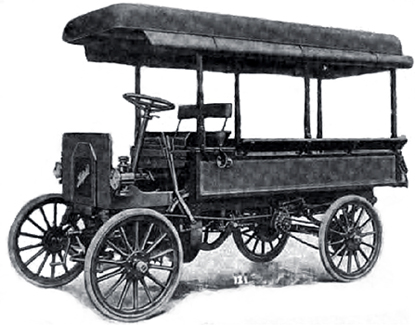
The Hatfield Auto Truck Company's One-Ton Model K
~1912
NOTE: This picture accompanies the
article entitled, "Hatfield Delivery Models" below
"Shocked," would be a huge understatement with regard to my reaction when I stumbled across this buried treasure!
While conducting my periodic search using specific keywords (e.g., "California Perfume Company" and "D H McConnell" among others) on sites like Google and Bing, I discovered a deeply hidden nugget concerning McConnell and his long time business partner, Alexander D. Henderson. The following entry was found in Operations & Maintenance magazine, Vol. 7, No. 3 dated March 3, 1912 in the section entitled, "Recent Truck Incorporations"
Hatfield Auto Truck Company of Elmira, N.Y.;
capital $1,500,000; incorporators D. H. McConnell, A. D. Henderson,
and
Arthur S. Hoyt.
What!?!?! A vehicle manufacturing company!?!? Was there ANYTHING that McConnell wasn't into??? So, I started digging deeper! And following are some of the gems I unearthed:
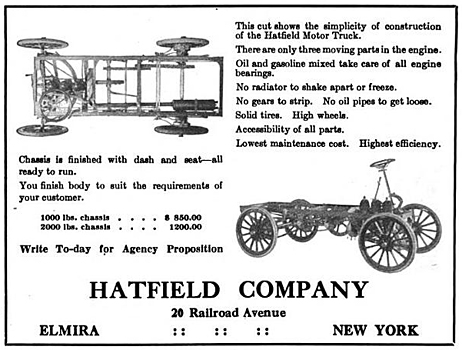 Hatfield Auto Truck Advertisement ~1912 Note: Advertisement found in The Automobile Trade Journal, Vol. 17, No. 11, dated May 1, 1912 on page 266 |
The following article was found in The Automobile Journal, Vol. 34, No. 11, published January 10, 1913, on page 122:
HATFIELD DELIVERY MODELS
Two Three-Cylinder, Two-Cycle, Air-Cooled Models Present Novel Features.
The Hatfield Auto Truck Company, Elmira, N. Y., is producing two models of the Hatfield delivery wagon, these being rated at 1000 and 2000 pounds. The main differences are in the spring and tire sizes, and in the wheelbase, former having 88 inches and the latter 96. A particular feature lies in the construction of the front axle, which is the same as that utilized in animal wagons and swings on a king bolt on a turntable.
The motor is a three-cylinder, two-cycle, air-cooled unit, with bore of 4.125 inches and stroke of four, rated at 18-20 horsepower. It is maintained that of the 99 parts in the motor, [all] but nine are moving. The cylinders are cast with wide and thin longitudinal fins and the heads are spherical. The rim of the flywheel carries a series of blades which serve as a fan. The cylinders are covered with a light metal shield or jacket which has an opening close to the screen in the hood, and there is a deck about the bottom of the radiating fins. The suction of the flywheel draws a current of air over the motor and down between the fins, radiating the heat.
A driven wheel on the cross shaft contacts with a plate attached to the rear face of the flywheel. Thence power is transmitted to a sprocket on the cross shaft to the jackshaft, and final drive is by side chains. There is no bevel and pinion device in the jackshaft, but an expanding cam is enclosed in the brake drums on the ends of this shaft, and these are claimed to operate satisfactorily in making turns.
The frame is of
angle steel and the springs are held to be ample. The service brake is
on the jackshaft and the emergency member, on the rear wheels. Tires are
34 by three inches in front and 34 by 3.5 in rear.
|
|
Also, a very short article found in The Automobile Trade Journal, Vol. 17, No. 12, dated June 1, 1912 within the "Commercial MotorCar Department" on page 200 revealed that the, "Hatfield Auto Truck Company, Elmira NY has increased its capital to $1,500,000 [and] are now making four of their one and one-half ton trucks per day which does not begin to meet the demand."
The latest reference thus far discovered is a congressional document from 1917 (H.R. 4280) on revenues to defray the expenses incurred due to US participation in World War One, wherein the Hatfield Auto Truck Company is identified as a participant in the hearings and briefings.
My assumption at this point is that the "Hatfield" Delivery Trucks were a short-lived vehicle. Interestingly, one of these vehicles is displayed at the Drake Well museum in Titusville, PA. According to museum's information, their Hatfield Model G, half-ton, represents one of only three still in existence. The museum literature also notes, "[in] late 1913, the company relocated to Pennsylvania in search of much needed capital, which failed, and the Hatfield Company ceased production."
Now...tying this all back to McConnell...the KEY seems to be Arthur S. Hoyt!
Of the scant articles and references to the Hatfield Auto Truck Company, only the announcements of incorporation found in multiple 1912 automobile magazines identify David H. McConnell (or D. H. McConnell) as being associated with the company. And for that matter, none of the incorporation announcements define McConnell's position within Hatfield. Furthermore, the Avon Archives in the Hagley Museum and Library apparently possesses no documentation regarding the Hatfield Auto Truck Company either. Soooo, again, who is Arthur S. Hoyt?
As found in the 1913 edition of Who's Who in New York City and State on page 491, Arthur S. Hoyt:
Starch manufacturer; born: Mallory, N. Y., Feb. 9, 1855 ; parents: Joseph J. and Emily (House) Hoyt; education: Oswego Normal School, Syracuse University; married: Mallory, N. Y. Nov. 4, 1878, Emma L. Starr; President Eastern Boroughs Land Co., Merchants Land & Development Co., Hatfield Auto Co., New York—Canada farms; Director G. W. Carmick Co., Atlantic Starch Works; Honorary Member 7th Connecticut Volunteer Infantry; Republican Congressional Member Brooklyn Institute; President Oswego Alumni Association; Club: Hardware; Address: 90 West Broadway, N. Y. City.
Interesting!!! And telling!!!! Hoyt was a long-time associate of McConnell's...attending the same school, Oswego Normal School, as well as working together in various business ventures: Merchants Land & Development Co. (Hoyt was President, McConnell was Vice President); Hatfield Auto Co., (Hoyt was President, McConnell was at least an investor, more probably a company officer); New York —Canada farms (Hoyt was President, McConnell was Vice President); and G. W. Carmick Co. (Hoyt was Director, McConnell was Treasurer.) So, McConnell's interest in vehicle manufacture...my guess is "not-so-much." It is clear, however, that McConnell and Henderson partnered with Hoyt to launch the Hatfield business...but the "rest of the story" is still a mystery...and the search definitely continues!
If you have ANY additional information on the Hatfield Auto Truck Company or you have pictures of one of these rare vehicles, please contact me at george (at) californiaperfumecompany.com.
Happy hunting!
An Update to this Article:
|
|
|
|
|
|
Immediately above are photographs of the 1912 Hatfield Auto Truck, Model G currently displayed at the Drake Oil Well Museum. Thanks to Drake Wells!
If you have ANY additional information on the Hatfield Auto Truck Company or you have pictures of one of these rare vehicles, please contact me at george (at) californiaperfumecompany.com.
Happy hunting!
Rare Daphne Perfume in Gift Box F Bottle!
Early-1920's
|
The Gift Box F is arguably among the most beautiful, and elegantly-designed, products sold under the California Perfume Company's banner. The simple, square bottle was topped by a hand cut glass prism stopper and tied with white ribbon. And, as noted in the description above, a leatherette-covered case padded with silk completed the Gift Box F package. Of important note in this 1911 Christmas Boxes catalog description is the fact that the Gift Box F was only "put up" in Crab Apple Blossom perfume. This classy, somewhat sophisticated, Gift Box perfume proved to be a huge sales success guaranteeing its inclusion in the California Perfume Company product line from at least 1911 through 1923, and possibly into early-1924.
Beginning in 1913, the Gift Box F was illustrated within the Gift Box section of the CPC Catalog (page 60). In that description (extremely similar to the description used in the 1911 Christmas Boxes catalog), TWO choices of perfume fragrance were now available: Crab Apple Blossom and Trailing Arbutus. These two fragrances continued to be the mainstay of the Gift Box F throughout its 13-year sales run. In 1922, after eleven years of production, the California Perfume Company expanded the Gift Box F fragrance choices by including American Ideal and Daphne perfumes. Two references were thus far discovered in the representatives' CPC Outlook magazines: 1) The March 1922 Outlook included a single page with six hand drawn "mini- advertisements" or sales suggestions. One of those mini-advertisements (seen immediately to the right) offered the Gift Box F put up with Daphne perfume as an "Easter gift." Please note the label depicted on the bottle in the hand-drawn illustration closely resembles the label styling seen on the bottle above, at the beginning of this article. 2) The November 1922 Outlook announced November Sales Prizes that included, as Class Two Prizes, 35 two ounce cut glass bottles of Daphne perfume. The following description was provided in that announcement: "This perfume is one of our most popular odors and it is put up in our regular "F" box. The container is a genuine cut glass bottle, with a hand cut prism ground glass stopper, kidded and ribboned, with a gold metal embossed label. The box is a rich case. We consider it one of the handsomest packages in the line." Please note the label identified in this description was the "gold metal embossed" label...as can be seen on the illustration from the 1911 Christmas Boxes catalog (above right). These label distinctions are called out to underscore the extreme rarity of the bottle pictured at the top of this article. The gold metal embossed labels have been found on almost all of the Gift Box F bottles discovered to date. The above bottle represents only the second example found sporting the classic Daphne label. The first example was pictured in the Avon 8 Avon Collector's Encyclopedia produced in 1985. The current disposition of that bottle is unknown. The above example was purchased on e-Bay in December, 2012. A couple of other important facts: the 1923 Color Plate catalog clearly described the Gift Box F as being available in Crab Apple Blossoms, Trailing Arbutus, American Ideal, and Daphne fragrances; however, the 1924 Color Plate catalog no longer illustrated the Gift Box F. The Gift Box F sales tapered off through the early 1920's and the "F" box was removed from the line in late-1923 or early-1924. Correlating this back to the label styles, the Daphne label would only have been available for one, no more that two, years..during the tapering, or slowing, sales. Therefore... All in all, the Gift Box F put up with Daphne perfume is a real treasure in any CPC collection! Happy hunting. If you have any comments, please contact me at george (at) californiaperfumecompany.com. |
California Perfume Company Summer Outing 1913!
|
In the summer of 1913, this handsome, finely-dressed group of California Perfume Company employees gathered on a forgotten field along a beautiful lake setting to enjoy their annual CPC Summer Outing. The folks represented in this picture include Suffern Laboratory employees and Main Office (31 Park Place, New York) staff. If it could be said that that Depot Managers and General Agents (the Representatives and District Managers of the time) were the hands, feet, and voice of the California Perfume Company, then the folks pictured above could easily be considered "the heart and soul" of the company! For it was this group of folks that ensured quality good were produced and shipped in a timely manner; that conducted administrative and financial matters properly and expeditiously; and that enabled the thousands of women and men across the country to enjoy successful, fruitful businesses as California Perfume Company representatives. This picture was discovered along with two other early CPC Summer Outing pictures (of undisclosed location and unknown date) and all sorts of ephemera concerning the Suffern Laboratory during the Allied Products, Inc. and Avon-Allied Products, Inc. days. Being able to get a glimpse into the history of the California Perfume Company, especially finding an authentic photograph dating back one century, is as personally rewarding as discovering a rare CPC bottle or tin. This company made a huge difference in the lives of so many women and men: facilitating the purchase of cars and homes, establishing prosperous businesses even during periods of economic turbulence. And finding these special artifacts definitely serves to connect one with our fine American history! Happy hunting. If you have any comments, please contact me at george (at) californiaperfumecompany.com. |

